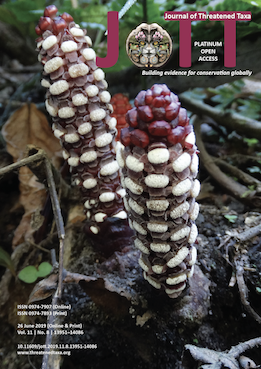First camera trap documentation of the Crab-eating Mongoose Herpestes urva (Hodgson, 1836) (Carnivora: Feliformia: Herpestidae) in Barandabhar Corridor Forest in Chitwan, Nepal
Main Article Content
Abstract
The systematic study in 2015 and 2016 documented the first camera trap image of the Crab-eating Mongoose Herpestes urva in Barandabhar Corridor Forest in Chitwan, Nepal. The corridor was divided into 88 grids, each of 1km by 1km. A pair of cameras was placed for 15 nights in each grid and the total camera trap night effort was 2,640. There were two separate events capturing three independent images and five separate events capturing seven independent images of the Crab-eating Mongoose in 2015 and 2016, respectively. Photo capture rate in camera traps were 0.01 and 0.03 respectively in 2015 and 2016. The presence of this species opens new scope for wildlife professionals and scientific communities to take further steps for its conservation.
Article Details
Authors own the copyright to the articles published in JoTT. This is indicated explicitly in each publication. The authors grant permission to the publisher Wildlife Information Liaison Development (WILD) Society to publish the article in the Journal of Threatened Taxa. The authors recognize WILD as the original publisher, and to sell hard copies of the Journal and article to any buyer. JoTT is registered under the Creative Commons Attribution 4.0 International License (CC BY), which allows authors to retain copyright ownership. Under this license the authors allow anyone to download, cite, use the data, modify, reprint, copy and distribute provided the authors and source of publication are credited through appropriate citations (e.g., Son et al. (2016). Bats (Mammalia: Chiroptera) of the southeastern Truong Son Mountains, Quang Ngai Province, Vietnam. Journal of Threatened Taxa 8(7): 8953–8969. https://doi.org/10.11609/jott.2785.8.7.8953-8969). Users of the data do not require specific permission from the authors or the publisher.
References
Axelsson, E.P. & J. Andersson (2012). A case study of termite mound occurrence in relation to forest edges and canopy cover within the Barandabhar Forest Corridor in Nepal. International Journal of Biodiversity and Conservation 4(15): 633–641.
Bhattarai, B.F. & K. Basnet (2004). Assessment of crop damage by wild ungulates in the eastern side of Barandabhar Corridor Forest, Chitwan. Proceedings of IV National Conference on Science and Technology, March 23–26.
Chuang, S.A. & L.L. Lee (1997). Food habits of three carnivore species (Viverricula indica, Herpestes urva, and Melogale moschata) in Fushan Forest ecosystem, northern Taiwan. Journal of Zoology 243(1): 71–79.
De, J.K. & R. Chakraborty (1995). Structure and pattern of guard hairs of Crab-eating Mongoose, Herpestes urva (Hodgson) (Mammalia: Carnivora: Herpestidae). Proceeding of the Zoological Society, Calcutta 48: 33–36.
Fry, T.B. (1925). Report No. 37a: Nepal. Bombay Natural History Society’s Mammal Survey of India, Burma, and Ceylon. Journal of the Bombay Natural History Society 30: 525–530.
Hodgson, B.H. (1836). Synoptical description of sundry new animals, enumerated in the Catalogue of Nepalese Mammals. Journal of the Asiatic Society of Bengal 5: 231–238.
Jnawali, S.R., H.S. Baral, S. Lee, K.P. Acharya, G.P. Upadhyay, M. Pandey, R. Shrestha, D. Joshi, B.R. Lamichhane, J. Griffiths, A. Khatiwada & R. Amin (compilers) (2011). The Status of Nepal Mammals: The National Red List Series. Department of National Parks and Wildlife Conservation, Kathmandu, Nepal, viii+81pp.
Karanth, K.U. & J.D. Nichols (2002). Monitoring tigers and their prey: a manual for researchers, managers, and conservationists in tropical Asia. Centre for Wildlife Studies, Bangalore, India.
Lamichhane, B.R., M. Dhakal, N. Subedi & C.P. Pokheral (2014). Clouded Leopard co-exist with other five felids in Chitwan National Park, Nepal. Cat News 61: 30–32.
Pokharel, C.P. (2002). Censusing tigers by camera trapping: testing the method and estimating the population in Karnali floodplain of Royal Bardia National Park, Nepal. M.Sc. Thesis. Agriculture University of Norway.
Puth, L.M. & K.A. Wilson (2001). Boundaries and corridors as a continuum of ecological flow control: lessons from rivers and streams. Conservation Biology 15: 21–30.
Silver, S., L. Ostro, L. Marsh, L. Maffei, A. Noss, M. Kelly & G. Ayala (2004). The use of camera traps for estimating Jaguar Panthera onca abundance and density using capture/recapture analysis. Oryx 38(2): 148–154. https://doi.org/10.1017/S0030605304000286
Sharma, B. & B.R. Lamichhane (2017). Record of Crab-eating Mongoose Herpestes urva from Parsa Wildlife Reserve, central Nepal. Small Carnivore Conservation 55: 97–103.
Thapa, S. (2013). Observations of Crab-eating Mongoose Herpestes urva in eastern Nepal. Small Carnivore Conservation 49: 31–33.
Than Zaw, Saw Htun, Saw Htoo Tha Po, Myint Maung, A.J. Lynam, Kyaw Thinn Latt & J.W. Duckworth (2008). Status and distribution of small carnivores in Myanmar. Small Carnivore Conservation 38: 2–28.
Wang, S.W. & D.W. MacDonald (2009). Feeding habits and niche partitioning in a predator guild composed of tigers, leopards and Dholes in a temperate ecosystem in central Bhutan. Journal of Zoology 277(4): 275–283.
Yonzon, P. (2005). Mongoose trade in Nepal. Tiger Paper: Regional Quarterly Bulletin on Wildlife and National Parks Management 32(2): 14–16.

